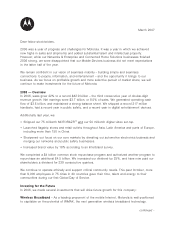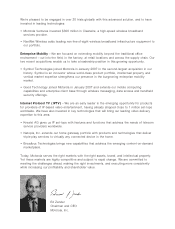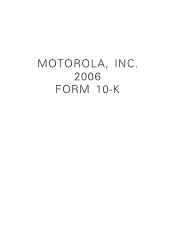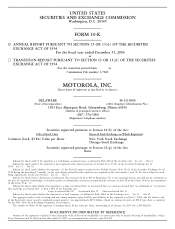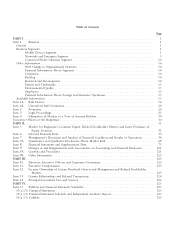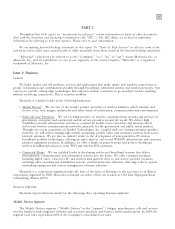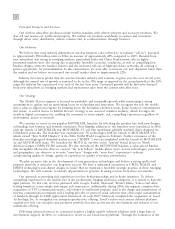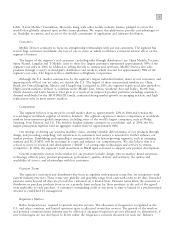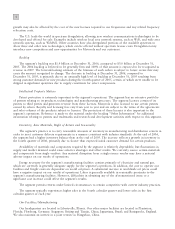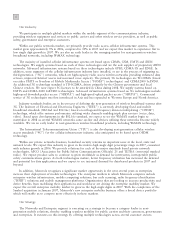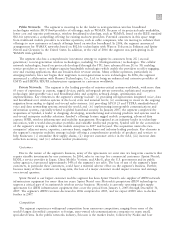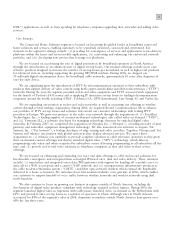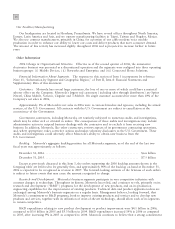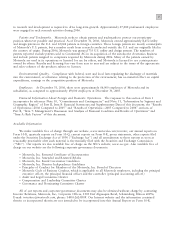Motorola 2006 Annual Report Download - page 13
Download and view the complete annual report
Please find page 13 of the 2006 Motorola annual report below. You can navigate through the pages in the report by either clicking on the pages listed below, or by using the keyword search tool below to find specific information within the annual report.
5
We also use several electronics manufacturing suppliers (""EMS'') and original design manufacturers (""ODM'')
to enhance our ability to lower our costs and deliver products that meet consumer demands in the rapidly-changing
technological environment. A portion of our handsets are manufactured either completely or substantially by non-
affiliated EMS and ODM manufacturers and the percentage of total manufactured unit volume with these
manufacturers increased moderately from 2005 to 2006.
In 2006, our handsets were primarily manufactured in Asia. We expect this to continue in 2007. Our largest
manufacturing facilities are located in China, Singapore and Brazil. Each of these facilities serves multiple countries
and regions of the world.
Networks and Enterprise Segment
The Networks and Enterprise segment (the ""segment'') designs, manufactures, sells, installs and services:
(i) cellular infrastructure systems and wireless broadband systems to public carriers and other wireless service
providers (referred to as the ""public networks'' market), and (ii) analog and digital two-way radio, voice and data
communications products and systems, as well as wireless broadband systems, to a wide range of public safety,
government, utility, transportation and other worldwide enterprise markets (referred to as the ""private networks''
market). In January 2007, the segment completed the acquisition of Symbol Technologies, Inc. (""Symbol''), a
leader in providing products and systems used in end-to-end enterprise mobility solutions. Symbol will become the
cornerstone of the segment's enterprise mobility strategy. In 2006, the segment's net sales represented 26% of the
Company's consolidated net sales.
Principal Products and Services
In the public networks market, the segment provides end-to-end cellular networks, including radio base
stations, base station controllers, associated software and services, application platforms and third-party switching
for CDMA, GSM, iDEN» and UMTS technologies. The segment also offers a portfolio of products, collectively
known as Motorola MOTOwi4, which includes WiMAX, to create mobile Internet Protocol (""IP'') broadband
access. These technologies, especially WiMAX, have the potential to make mobile bandwidth more affordable and
accessible for mainstream consumer adoption, yet profitable for the segment's service provider customers. The
segment also provides access points, subscriber modules and backhaul modules for wireless broadband systems, as
well as advanced telecommunications architecture (""TCA'') and micro TCA communications servers. These
products and services are marketed to wireless service providers worldwide through a direct sales force, licensees
and agents.
In the private networks market, the segment primarily designs, manufactures, sells, installs and services two-way
radio, voice and data communications products and systems to a wide range of public safety and government
customers worldwide.
The segment also serves the enterprise space by providing business-critical wireless mobility devices, networks
and applications that enable an enterprise customer to seamlessly connect its people, assets and information.
Enterprise customers include utility, courier, transportation, field services and other companies with disseminated
workforces. Offerings include mobile office devices, rugged mobile computing handhelds, private and public
business communication networks, enterprise-grade wireless security systems, and end-to-end systems and
applications that deliver enterprise mobility. The January 2007 acquisition of Symbol unites the two companies'
industry-leading enterprise products.
The segment's products are sold directly through its own distribution force or through independent authorized
distributors and dealers, service operators and independent commission sales representatives. The segment's
distribution organization provides systems engineering and installation and other technical and systems management
services to meet its customers' particular needs. The customer may also choose to install and maintain the
equipment with its own employees, or may obtain installation, service and parts from a network of the segment's
authorized service stations (most of whom are also authorized dealers) or from other non-Motorola service
stations.


